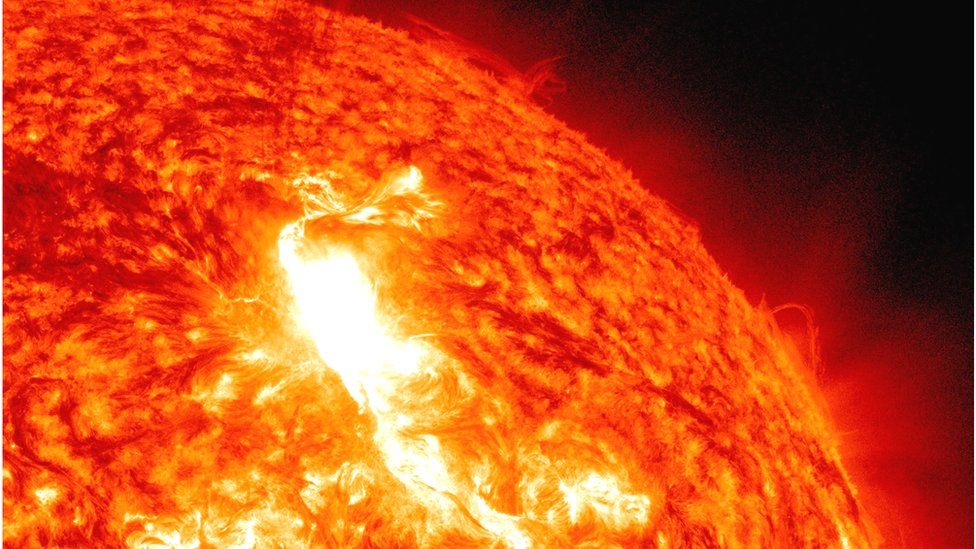ARTICLE AD BOX
 Image source, NASA
Image source, NASA
Solar panels in space would be able to collect sunlight unfiltered by the atmosphere
By Emma Woollacott
Technology of Business reporter
It sounds too good to be true: a plan to harvest solar energy from space and beam it down to Earth using microwaves.
But it's something that could be happening as soon as 2035, according to Martin Soltau, the co-chairman at Space Energy Initiative (SEI) - a collaboration of industry and academics.
SEI is working on a project called Cassiopeia, which plans to place a constellation of very large satellites in a high Earth orbit.
Once deployed the satellites would harvest solar energy and beam it back down to Earth.
He says the potential is almost unlimited.
"In theory it could supply all of the world's energy in 2050," he says.
"There's sufficient room in orbit for the solar power satellites, and the Sun's supply of energy is vast. A narrow strip around geostationary Earth orbit receives more than 100 times the amount of energy per year than all of humanity is forecast to use in 2050," Mr Soltau says.
Earlier this year, the UK government announced £3m in funding for space-based solar power (SBSP) projects, following an engineering study conducted by consultancy Frazer-Nash that concluded the technology was viable.
SEI is hoping to get a big chunk of that money.
Its satellites would be made up of hundreds of thousands of small, identical modules produced in factories on Earth, and assembled in space by autonomous robots, who would also carry out servicing and maintenance.
The solar energy collected by the satellites would be converted into high frequency radio waves and beamed to a rectifying antenna on Earth, which would convert the radio waves into electricity.
Each satellite could deliver around 2GW of power into the grid, making each satellite comparable in power output to a nuclear power station.
Here on Earth, sunlight is diffused by the atmosphere, but in space it comes directly from the sun without interference.
So a space-based solar panel can collect a lot more energy than a similar sized one on Earth.
Similar projects are under development elsewhere.
Image source, SEI
Image caption,The Space Energy Initiative has designed satellites to collect solar energy in space
In the US, for example, the Air Force Research Laboratory (AFRL) is working on some of the critical technologies needed for such a system, in a project known as Space Solar Power Incremental Demonstrations and Research (SSPIDR).
These include improving solar cell efficiencies, solar-to-radio frequency conversion and beam forming, as well as reducing the large temperature fluctuations on spacecraft components and creating designs for deployable structures.
Late last year, the team successfully demonstrated new components for a so-called sandwich tile, which is used to convert solar energy into radio waves.
The microwave beams might sound alarming, but it has been demonstrated on Earth, and found to be effective and safe for both humans and wildlife.
"The beam is microwave, so it's just like the wi-fi that we have all the time, and it's low-intensity, at about a quarter of the intensity of the midday Sun," says Mr Soltau.
"If you were on the equator in the desert, you'd get about 1,000W per square metre, and this is about a quarter of that: about 240W per square metre. So it's inherently safe in that respect."
While many of the biggest hurdles have already been cleared, there are still potential problems.
"My personal take on this is that we like to think the technology is there, but it's not quite ready yet for us to embark on a project of such complexity," says Dr Jovana Radulovic, a thermodynamics lecturer at the University of Portsmouth, who specialises in renewable energy systems.
She makes the point that launching a large number of solar panels into space will be expensive and, given that any project could require hundreds of launches, it would generate a lot of carbon dioxide.
But there is cause for optimism. An environmental analysis of the Cassiopeia project by the University of Strathclyde has concluded that overall, including launch, the carbon footprint could be as little as half that of terrestrial solar, at about 24g of CO2 per kilowatt-hour.
Image source, SEI
Image caption,Space-based solar farms could potentially supply all the world's energy, says Martin Soltau
Meanwhile, says Mr Soltau, the economic case is improving all the time.
"The cost of launch has fallen by 90% and is continuing to fall, and this has been game-changing for the economics," he says.
"Secondly, there have been some real advances in the design of solar power satellites, so that they're much more modular, which provides resilience and reduced production costs. Thirdly, we've got real advances in robotics and autonomous systems."
With only limited funding from the UK government, SEI is hoping to attract private investment for some of the technologies involved. However, warns Dr Radulovic, the proposed timeline may be over-optimistic.
"I think with significant investment and focused effort into this area, there's no reason why we couldn't have the system up and running as smaller pilot projects in the foreseeable future," she says.
"But something on a large scale - we are talking about kilometres of solar arrays - would take a substantially longer time."

 2 years ago
63
2 years ago
63








 English (US) ·
English (US) ·